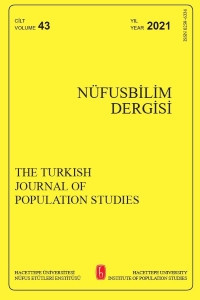OSMANLI’DA MODERN ANLAMDA YAPILAN İLK NÜFUS SAYIMINA GÖRE DİVRİĞİ’NİN DEMOGRAFİK YAPISI
Osmanlı İmparatorluğu’nda daha önce gerçekleştirilen nüfus sayımlarında sadece erkek nüfusunun tespitine yönelik sayımların yapıldığı ve ancak, 1882’de modern anlamda yapıldığı söylenilen sayımda kadınlara yer verildiği belirtilmektedir. Halbuki, halen Cumhuriyet Üniversitesi Tarih Bölümü Kütüphanesi’nde muhafaza edilen Divriği’ye ait iki ciltlik 1870(H.1286) tarihli Esas Nüfus Defterleri’ne bakıldığında, 1882’de modern anlamda yapıldığı söylenilen sayımın aslında, 1870’te gerçekleştiği ve bu sayımda kadınların da nüfusa yazıldığı görülmektedir. İşte burada, İmparatorlukta modern anlamda yapılan bu ilk nüfus sayımında yer alan verilerden hareketle, o günkü bir Anadolu kasabasının hane nüfusunun sayısal olarak büyüklüğüne; kadın erkek nüfus oranına, nüfusun yaş ortalaması ile doğurganlık ve ölüm oranlarına dair bilgi edinilmeye çalışılacaktır. Ayrıca defterlerde başta hane reisi olmak üzere hanede çalışan veya çalışabilir durumdaki nüfusun mesleği, meşgalesi yıllık kazancı ve bu yıllık kazançtan alınan vergi nispeti belirtilmiş olduğundan bu veriler de değerlendirilecektir. Böylece, imparatorlukta modern anlamda ilk kez yapılan bir nüfus sayımındaki verilerden hareket edilerek 1870’lerde bir Anadolu kasabasının kırsal alanındaki yaşamının genel görüntüsü verilmeye çalışılacaktır.
THE DEMOGRAPHIC MAKE-UP OF DIVRIGI ACCORDING TO THE FIRST MODERN CENSUS OF THE OTTOMAN EMPIRE
It has been argued that census conducted at the time of the Ottoman Empire was based soley on the determination of the male population and that women were only included in the census in modern terms in 1882. However, what is being emphasised in this study, and what clearly is the case when one looks at the two volumes of work on Divrigi from 1870 (1286 Islamic Calender) titled Real Population Books, (which is still kept in the History Department’s Library at Cumhuriyet University), is that women were included in the 1870 census data rather than the argued date of 1882. This study will try to gather information on the size of the population, the male to female ratio of the population, the average age of the population, and the birth and death rates at the time using data from what in modern terms was the first census conducted by the Empire on an Anatolian town at the time. Moreover, since data is also available on the following; those working within each household (beginning with the head of the family), their occupation, or the profession of those able to work, their annual income, and the proportion of annual tax taken from their earnings, this information will also be evaluated in this study. Thus, in this way a general rural lifestyle portrait of an Anatolian town of the 1870s will be drawn using what in modern terms is the Empire’s first census data.
- ISSN: 0259-6334
- Başlangıç: 1979
- Yayıncı: Hacettepe Üniversitesi
Sayıdaki Diğer Makaleler
Türkiye için Hayat Tablolarının Sentetik Yetimlik Tekniği ile Oluşturulması
Sinan TÜRKYILMAZ, Attila HANCIOĞLU
Türkiye'de İç Göç Ve Çocuk Sağlığı
Sabahat TEZCAN, Mehmet Ali ERYURT
OSMANLI’DA MODERN ANLAMDA YAPILAN İLK NÜFUS SAYIMINA GÖRE DİVRİĞİ’NİN DEMOGRAFİK YAPISI
TÜRKİYE’DE ÖLÜM KAYITLARINA İLİŞKİN SORUNLAR: ANNE ÖLÜMLERİ ÖZELİNDE NİTELİKSEL BİR ÇALIŞMA
Banu Akadlı ERGÖÇMEN, İlknur YÜKSEL
NÜFUS SAYIMLARINDAKİ YAŞ DAĞILIM HATALARININ DÜZELTİLMESİ İÇİN KERNEL TAHMİN YÖNTEMİNİN UYGULAMASI
